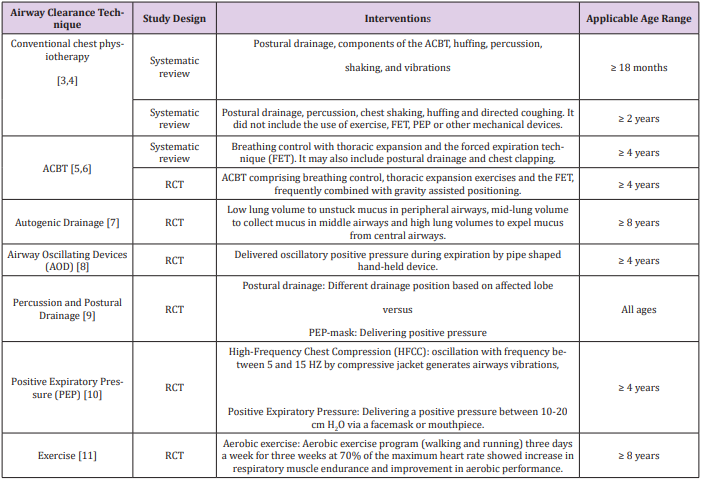Evidence Based Chest Physiotherapy for Cystic Fibrosis
Introduction
Pulmonary diseases regarded as one of the main sources of limitation in daily livelihood. These limitations are highly influenced by difficulties to clear bronchial secretions, symptoms of breathlessness and decrease exercise tolerance [1]. Chest disease like cystic fibrosis (CF) exhibited similar features described as earlier. However, CF is associated with morbidity and an infrequent threat of life [2]. CF is a genetic disease characterized by dehydration of airway surface liquid and causing difficulties of mucociliary clearance. As a result patients experience chronic pulmonary infections as well as inflammation.
Methods
Sixty experimental and quasi experimental studies were found using PUBMED, GOOGLE SCHOLAR, CINAHL and HINARI in which eight were cross over studies focusing on chest physiotherapy techniques. Among those one investigated the effects of autogenic drainage, six focused on conventional chest physiotherapy, three applied oscillating positive expiratory pressure, seven investigated the effects of positive expiratory pressure and another one examined the effects of high pressure positive expiratory pressure on respiratory functions.
Among the eight crosses over studies, six experiments focused on single treatment approaches in which four experiments comprising of 28 participants was found a huge amount of expelled secretions after application of chest physiotherapy when compared to no treatment option. One experiment was conducted on 18 participants and found similarities of sputum weight when compared to control group. However, another one study found that chest physiotherapy for CF was solely based on airway clearance techniques and these were Positive Expiratory Pressure (PEP) mask therapy, High pressure PEP (HPEP) mask therapy, ACBT, autogenic drainage, exercise and oscillating devices. Four reviews addressed Percussion and Postural Drainage (P&PD), two reviews addressed Positive Expiratory Pressure (PEP) and two addressed physical training. Among the nineteen additional controlled trials, five studies assessed P&PD, two PEP, four Oscillatory PEP (OPEP), six assessed High Frequency Chest Compressions (HFCC), three physical or exercise training, three ACBT and no additional studies were identified addressing high pressure PEP (HPEP) or Autogenic Drainage (AD).
Discussion:
(Table: 1) [3-11]
Conclusion
CF is a disabling condition causing impairments in lung function. The huge production of sections and symptoms of breathlessness is an emergency. This short communication found that evidence based chest physiotherapy techniques helped to clear secretion and provided eases in breathing .Thus a person with CF can maintain better quality of life through application of evidence based and appropriately indicated chest physiotherapy.
More BJSTR Articles : https://biomedres01.blogspot.com/



No comments:
Post a Comment
Note: Only a member of this blog may post a comment.